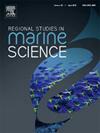How different are the nematode communities between the two main habitats of a mangrove forest? Insights from a subtropical mangrove forest
IF 2.1
4区 环境科学与生态学
Q3 ECOLOGY
引用次数: 0
Abstract
Sediment (inbenthic habitat) and fallen leaf (epibenthic habitat) are two distinguishable habitats inside the mangrove forests. In September 2020, sediment samples and leaf litter were collected from a subtropical mangrove forest, namely the Futian Mangrove Nature Reserve, in China. Subsequently, free-living marine nematodes were investigated to assess differences between the two habitats, and understand the important factors shaping nematode community in the mangrove ecosystem. Leaf litter were collected and divided into three decay degrees to reveal the successive changes of nematodes with leaf litter degradation. The results showed that nematode community on fallen leaves was characterized by the abundant Monhysteridae nematodes and the non-selective deposit feeders, which was different from the community in sediments where Linhomeidae and Chromadoridae nematodes and selective deposit feeders dominated. In general, bacterivores dominated at both habitats. Spatial variations of nematode community structure and diversity were observed at both habitats. TOM appeared as the significant factor affecting nematode community in the sediment, exhibited a negative correlation with nematodes diversity; while the spatial variations in nematodes on the fallen leaves were related to the concentrations of condensed tannin of the leaf litter. In addition, the spatial differences in nematode abundance and species composition observed in this study also were linked to differences in mangrove tree species. A subtle increase in the relative abundance of Diplolaimelloides and Diplolaimella with increasing degradation of leaves was observed, which might be due to their characteristics of opportunistic colonizers, the continuous changes in the concentrations of condensed tannin and/or microbial activity of the leaf litter.
红树林的两个主要栖息地之间的线虫群落有何不同?来自亚热带红树林的洞察
沉积物(底栖动物栖息地)和落叶(底栖动物栖息地)是红树林中两种可区分的栖息地。2020年9月,在中国福田红树林自然保护区收集了亚热带红树林的沉积物样本和凋落叶。随后,对自由生活的海洋线虫进行了调查,以评估两种栖息地之间的差异,并了解红树林生态系统中线虫群落形成的重要因素。收集凋落叶并将其分为3个腐烂程度,揭示线虫随凋落叶降解的连续变化。结果表明:落叶上线虫群落以单足线虫科和非选择性沉积物取食者为主,而沉积物中线虫群落以Linhomeidae和Chromadoridae线虫科和选择性沉积物取食者为主;总的来说,食菌者在两种栖息地都占主导地位。观察了两种生境线虫群落结构和多样性的空间变化。TOM是影响沉积物中线虫群落的显著因子,与线虫多样性呈负相关;而凋落叶上线虫的空间分布则与凋落叶中缩合单宁的浓度有关。此外,本研究所观察到的线虫丰度和物种组成的空间差异也与红树林树种的差异有关。随着叶片退化程度的增加,双叶线虫和双叶线虫的相对丰度呈微妙的增加,这可能与它们的机会性定殖特征、凋落叶中缩合单宁浓度的持续变化和/或微生物活性有关。
本文章由计算机程序翻译,如有差异,请以英文原文为准。
求助全文
约1分钟内获得全文
求助全文
来源期刊

Regional Studies in Marine Science
Agricultural and Biological Sciences-Ecology, Evolution, Behavior and Systematics
CiteScore
3.90
自引率
4.80%
发文量
336
审稿时长
69 days
期刊介绍:
REGIONAL STUDIES IN MARINE SCIENCE will publish scientifically sound papers on regional aspects of maritime and marine resources in estuaries, coastal zones, continental shelf, the seas and oceans.
 求助内容:
求助内容: 应助结果提醒方式:
应助结果提醒方式:


